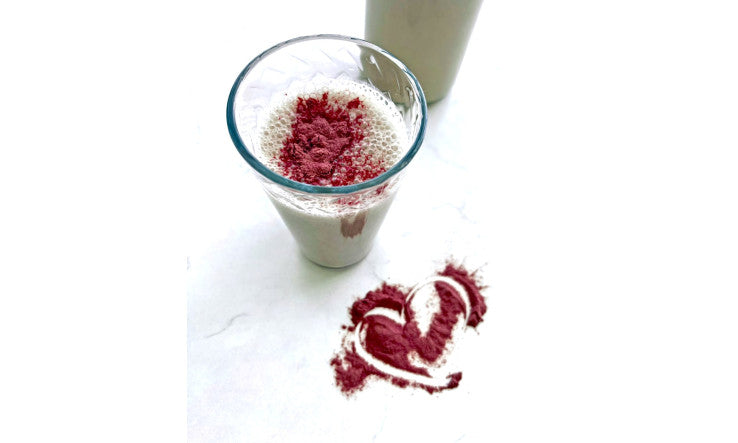A blend rich in phytonutrients and also contains a wide range of vitamins, minerals and fiber.
Vitis rotundifolia (Muscadine grapes)
Muscadine grapes are a fruit native to the southeastern United States that contain phenolic compounds that are equal to or superior to other berries and act as antioxidants. The antioxidant phytonutrients in muscadine grapes work by binding and inactivating free radicals in the blood and tissues. These include ellagic acid, myricetin, quercetin, kaempferol, resveratrol, and piceatannol, among others, considered the main compounds responsible for the effectiveness of grape powder, among their properties: 1,2,3,4,5,6,7
- To exert a cardioprotective effect in pre- and post-menopausal women, by lowering plasma lipids and reducing oxidative stress.
- To improve bone formation (demonstrated experimentally). This could have implications for the prevention of osteoporosis.
- Proven to be particularly beneficial in combating vasomotor symptoms of menopause and prostate health, as well as for its anti-carcinogenic, neuroprotective, cardioprotective and bone-forming properties.
- Kaempferol protects LDL from oxidation and prevents the formation and accumulation of plaque in the arteries - the basic process that causes heart attacks and strokes. It suppresses the growth of several malignant tumors in humans.
- Quercetin may help lower blood pressure in patients with high blood pressure.
- Along with resveratrol, quercetin has demonstrated anti-inflammatory properties (which may be helpful in Parkinson's disease). It is also cardioprotective.
- Ellagic acid has excellent free radical scavenging activity.
- The powder is 0.17 mg/gram for trans-resveratrol and 0.42 mg/gram for cis-resveratrol.
Acai (Euterpe oleracea)
This plant has been cultivated for thousands of years in the tropical regions of Central and South America as a versatile dietary plant. Its reputation has rapidly increased worldwide demand due to its nutritional and healing qualities, as its numerous bioactive phenolic compounds are credited with promoting and preventing disease.
A comprehensive, up-to-date assessment 8 has been presented regarding its phytochemicals with emphasis on cellular and molecular mechanisms of action, as well as its health benefits. In vitro and in vivo studies have shown that acai:
- Has antioxidant 9 and anti-inflammatory properties.
- Exerts cardioprotective, gastroprotective, hepatoprotective, neuroprotective, renoprotective, antilipidemic, antidiabetic and antineoplastic activities.
- Some clinical trials have suggested that acai may protect against metabolic stress induced by oxidation, inflammation, vascular abnormalities, and physical exertion.
Thanks to its medicinal properties and lack of side effects, acai therefore has a promising future in health promotion and disease prevention.
Acerola (Malpighia emarginata)
Acerola is a tropical fruit native to southern Mexico, Central America, and northern South America. It is rich in vitamins, carotenoids, anthocyanins, and bioactive compounds such as ascorbic acid. 10 Its high vitamin C content (695 to 4,827 mg/100 g) is truly remarkable. All of this gives it:
- Significant nutritional value and potential use as an antioxidant. 11
Amla (Phyllanthus emblica Linn.)
This tree, native to India and Southeast Asia, produces fruits rich in bioactive compounds. Scientific evidence indicates that polyphenols are central components of the fruits and other sections of the amla tree, along with vitamin C. The rich composition of polyphenols and vitamin C gives it significant antioxidant activity and supports its potential role in health promotion and disease prevention.
Among its other potential health activities are: 13
- Anti-hyperlipidemic
- Antidiabetic
- Anticancer
- Protector
- Anti-inflammatory
- Digestive
- Neurological
Aronia (Aronia melanocarpa)
Aronia berries differ in their content of minerals, vitamins, carbohydrates, amino acids, organic acids, fats, aromatic compounds and especially polyphenols, all substances that exert a beneficial effect on health and whose numerous activities are proven, such as: 14
- Antioxidant
- Anti-inflammatory
- Hypotensive
- Antiviral
- Anticancer
- Antiplatelet
- Antidiabetic
- Antiatherosclerotic
Camu camu (Myrciaria dubia)
Camu camu is a small shrub that grows near the Amazon River, primarily in Peru and Brazil. It produces a tangy red berry with several properties.
A systematic review 15 confirms its antioxidant capabilities and although it seems, based on the evidence to date, considering its unique vitamin C content compared to other tropical fruits, as well as its flavonoid and anthocyanin content. Camu camu plays a prospective role as:
- Mediator of inflammation and antioxidant stress
- It would be a natural way to increase vitamin C intake.
Cranberry (Vaccinium macrocarpon)
Cranberry is a rich source of bioactive compounds that make up a healthy diet. Rich in polyphenols such as phenolic acids, anthocyanins, and flavonoids, it is one of the few fruits rich in proanthocyanidins, which are associated with numerous health benefits. This systemic review provides information on its chemical composition, antioxidant effect, and the beneficial impact on human health and disease prevention after its consumption, and in particular its effect on: 16
- Urinary tract inflammation in adults and children
- Cardiovascular diseases
- Oncological diseases
- Type 2 diabetes
- Metabolic syndrome
- Obesity
- Tooth decay and periodontitis
- Helicobacter pylori bacteria in the stomach and other diseases.
Goji (Lycium barbarum)
Goji berries are commonly found in Asia, particularly in the northwest regions of China. In these reviews 17,18 , the aim was to focus on its bioactive compounds and pharmacological properties including their molecular mechanisms of action.
These little berries provide many health-protecting benefits, such as:
- Reduce oxidative stress and prevent free radicals from damaging DNA, lipids and proteins.
- Improving hematopoiesis, anti-radiation, anti-aging, anti-cancer, strengthening immunity and anti-oxidation.
Grape (Vitis vinifera L.)
Grapes are used not only for nutritional purposes, but also for exclusive therapeutic purposes. This review covers the literature that deals with the anticancer mechanism of resveratrol with particular reference to the antioxidant potential, since they are an important source of phytochemicals, especially resveratrol, a phytoalexin antioxidant present in red grapes that has effects and activities, both: 19
- Chemopreventive and therapeutic against various conditions
- Antimicrobial
- Antioxidant
- Anti-inflammatory
Maqui (Aristotelia chilensis)
Maqui is a shrub or tree native to Chile with exceptional antioxidant activity, associated with its high content of anthocyanins, polyphenols and flavonoids.
A review 20 summarizes and discusses relevant information on the cardioprotective potential of maqui, based on its composition of bioactive compounds, mainly as an antiplatelet nutraceutical agent. Articles published between 2000 and 2022 were selected, their research revealed that maqui is a promising cardiovascular target since extracts of this berry have direct effects on the reduction of cardiovascular risk factors:
- Glucose index
- Obesity
- Diabetes
Pomegranate (Punica granatum L.)
Pomegranate fruits have been widely consumed and used as preventive and therapeutic agents since ancient times. Pomegranate is a rich source of a variety of phytochemicals, which are responsible for its strong antioxidant and anti-inflammatory potential. 21
The aim of a review 22 was to provide an up-to-date overview of current knowledge on the chemical structure and potential health benefits of pomegranate. The literature, according to in vitro and in vivo studies, confirms that the juice and extracts obtained from different parts of this plant exert beneficial effects on health:
- Antidiabetic
- Antihypertensive
- Antimicrobial
- Antitumor
Sea buckthorn (Hippophaë rhamnoides L.)
Sea buckthorn is a plant with great virtues, it is a valuable plant with versatile properties, it is increasingly part of people's daily diet for the prevention and treatment of diet-related diseases. Its chemical composition is unique. A review 23 establishes a detailed analytical table of the current state of available knowledge and gives an overview of the qualities of sea buckthorn, its nutritional value, its beneficial properties for health and its applications. The exceptional value of sea buckthorn is reflected in the presence of antioxidants, mainly carotenoids and tocopherols, and hydrophilic antioxidants - flavonoids, tannins, phenolic acids, ascorbic acid - in remarkably high quantities. It therefore plays an important role in the functions 24 :
- Anti-inflammatory
- Antioxidant
- And in metabolic health
Baboab (Adansonia digitata L.)
The baobab tree is widely found in the forests and savannahs of sub-Saharan Africa. The baobab fruit is widely consumed there as it contains high nutritional value and provides a source of income for rural populations. Reported nutrient contents of different parts of the baobab tree show wide variation, which may stem from a variety of factors. 25,26,27,28,29
- Baobab pulp is particularly rich in vitamin C.
- These leaves are particularly rich in calcium and are known to contain good quality protein.
- Whole seeds and grains have a relatively high fat content.
- Both the pulp and leaves exhibit antioxidant properties with higher activity in the pulp than in the leaves.
- Baobab fruit pulps were found to be rich in procyanidins (anti-inflammatory) and flavanol glycosides (antioxidant and anti-inflammatory), with tiliroside (antidiabetic, hypolipidemic, antioxidant) being the main constituent. Baobab leaves showed a similar profile compared to fruits, but with more phenolic compounds detected.
- Baobab shell and fibrous filaments are sources of polyphenols and antioxidant dietary fiber.
- Baobab fruit is rich in dietary fiber and polyphenols and can therefore increase satiety. It may reduce hunger, possibly having a positive effect on weight maintenance.
References:
1. Okla M, Kang I, Kim DM, Gourineni V, Shay N, Gu L, Chung S. Ellagic acid modulates lipid accumulation in primary human adipocytes and human hepatoma Huh7 cells via discrete mechanisms. J Nutr Biochem. 2015 Jan;26(1):82-90. doi: 10.1016/j.jnutbio.2014.09.010. Epub 2014 Oct 20. PMID: 25458530.
2. Ignacio DN, Mason KD, Hackett-Morton EC, Albanese C, Ringer L, Wagner WD, Wang PC, Carducci MA, Kachhap SK, Paller CJ, Mendonca J, Li-Ying Chan L, Lin B, Hartle DK, Green JE, Brown CA, Hudson TS. Muscadine grape skin extract inhibits prostate cancer cells by inducing cell-cycle arrest and decreasing migration through heat shock proteins 40. Heliyon. 2019 Jan 16;5(1): e01128. doi: 10.1016/j.heliyon. 2019.e01128. PMID: 30705983; PMCID: PMC6348279.
3. Yi W, Fischer J, Akoh CC. Study of anticancer activities of muscadine grape phenolics in vitro. J Agric Food Chem. 2005 Nov 2;53(22):8804-12. doi:10.1021/jf0515328. PMID: 16248588
4. God JM, Tate P, Larcom LL. Anticancer effects of four varieties of muscadine grape. J Med Food. 2007 Mar;10(1):54-9. doi: 10.1089/jmf.2006.699. PMID: 17472467.
5. Greenspan, Phillip & Bauer, John & Pollock, Stanley & Gangemi, Joseph & Mayer, Eugene & Ghaffar, Abdul & Hargrove, James & Hartle, Diane. (2005). Antiinflammatory Properties of the Muscadine Grape (Vitis rotundifolia). Journalmuscadine.ultural and food chemistry. 53. 8481-4. 10.1021/jf058015+.
6. Hudson TS, Hartle DK, Hursting SD, Nunez NP, Wang TT, Young HA, Arany P, Green JE. Inhibition of prostate cancer growth by muscadine grape skin extract and resveratrol through distinct mechanisms. Cancer Res. 2007 Sep 1;67(17):8396-405. doi: 10.1158/0008-5472.CAN-06-4069. PMID: 17804756.
7. Bralley, Eve & Greenspan, Phillip & Hargrove, James & Hartle, Diane. (2008). Inhibition of Hyaluronidase Activity by Vitis rotundifolia. (Muscadine) Berry Seeds and Skins. Pharmaceutical Biology. 45. 667-673. 10.1080/13880200701545018.
8. Marcason W. What is the açaí berry and are there health benefits? Journal of the American Dietetic Association. 2009;109(11):1968.
9. Schauss AG, Wu (acai). J Agric Food Chem. 2006 Nov 1;54(22):8604-10. doi:10.1021/jf0609779. PMID: 17061840.
10. de Aquino Souza Miskinis R, do Nascimento LÁ, Colussi R. Bioactive compounds from acerola pomace: A review. Food Chem. 2023 Mar 15;404(Pt A):134613. doi: 10.1016/j.foodchem.2022.134613. Epub 2022 Oct 17. PMID: 36444022.
11. Mezadri T, Fernández-Pachón MS, Villaño D, García-Parrilla MC, Troncoso AM. The fruit of the acerola: composition, product characteristics and economic importance
12. Gul M, Liu ZW, Iahtisham-Ul-Haq, Rabail R, Faheem F, Walayat N, Nawaz A, Shabbir MA, Munekata PES, Lorenzo JM, Aadil RM. Functional and Nutraceutical Significance of Amla (Phyllanthus emblica L.): A Review. Antioxidants (Basel). 2022 Apr 22;11(5):816. doi:10.3390/antiox11050816. PMID: 35624683; PMCID: PMC9137578.
13. Krishnaveni M, Mirunalini S. Therapeutic potential of Phyllanthus emblica (amla): the ayurvedic wonder. J Basic Clin Physiol Pharmacol. 2010;21(1):93-105. doi: 10.1515/jbcpp.2010.21.1.93. PMID: 20506691.
14. Jurendić T, Ščetar M. Aronia melanocarpa Products and By-Products for Health and Nutrition: A Review. Antioxidants (Basel). 2021 Jun 29;10(7):1052. doi:10.3390/antiox10071052. PMID: 34209985; PMCID: PMC8300639.
15. Paul C. Langley, PhD, Joseph V. Pergolizzi, Jr., MD, Robert Taylor, Jr., PhD and Caroline Ridgway, JD. Antioxidant and Associated Capacities of Camu Camu (Myrciaria dubia): A Systematic Review- Journal of Alternative and Complementary Medicine. 2015 Jan 1; 21(1): 8–14. doi: 10.1089/acm.2014.0130, PMCID: PMC4296744, PMID: 25275221 https://www.ncbi.nlm.nih.gov/pmc/articles/PMC4296744/
16. Nemzer BV, Al-Taher F, Yashin A, Revelsky I, Yashin Y. Cranberry: Chemical Composition, Antioxidant Activity and Impact on Human Health: Overview. Molecules. 2022 Feb 23;27(5):1503. doi:10.3390/molecules27051503. PMID: 35268605; PMCID: PMC8911768.
17. Ma ZF, Zhang H, Teh SS, Wang CW, Zhang Y, Hayford F, Wang L, Ma T, Dong Z, Zhang Y, Zhu Y. Goji Berries as a Potential Natural Antioxidant Medicine: An Insight into Their Molecular Mechanisms of Action. Oxid Med Cell Longev. 2019 Jan 9; 2019:2437397. doi:10.1155/2019/2437397. PMID: 30728882; PMCID: PMC6343173.
18. Teixeira F, Silva AM, Delerue-Matos C, Rodrigues F. Lycium barbarum Berries (Solanaceae) as Source of Bioactive Compounds for Healthy Purposes: A Review. Int J Mol Sci. 2023 Mar 1;24(5):4777. doi:10.3390/ijms24054777. PMID: 36902206; PMCID: PMC10003350.
19. Rauf A, Imran M, Butt MS, Nadeem M, Peters DG, Mubarak MS. Resveratrol as an anti-cancer agent: A review. Crit Rev Food Sci Nutr. 2018 Jun 13;58(9):1428-1447. doi:10.1080/10408398.2016.1263597. Epub 2017 Jul 21. PMID: 28001084.
20. Rodríguez L, Trostchansky A, Vogel H, Wood I, Palomo I, Wehinger S, Fuentes E. A Comprehensive Literature Review on Cardioprotective Effects of Bioactive Compounds Present in Fruits of Aristotelia chilensis Stuntz (Maqui). Molecules. 2022 Sep 20;27(19):6147. doi:10.3390/molecules27196147. PMID: 36234679; PMCID: PMC9571323.
21. Vučić V, Grabež M, Trchounian A, Arsić A. Composition and Potential Health Benefits of Pomegranate: A Review. Curr Pharm Des. 2019;25(16):1817-1827. doi:10.2174/1381612825666190708183941. PMID: 31298147.
22. Benedetti G, Zabini F, Tagliavento L, Meneguzzo F, Calderone V, Testai L. An Overview of the Health Benefits, Extraction Methods and Improving the Properties of Pomegranate. Antioxidants (Basel). 2023 Jun 27;12(7):1351. doi:10.3390/antiox12071351. PMID: 37507891; PMCID: PMC10376364.
23. Gâtlan AM, Gutt G. Sea Buckthorn in Plant Based Diets. An Analytical Approach of Sea Buckthorn Fruits Composition: Nutritional Value, Applications, and Health Benefits. Int J Environ Res Public Health. 2021 Aug 26;18(17):8986. doi:10.3390/ijerph18178986. PMID: 34501575; PMCID: PMC8431556.
24. Ma X, Yang W, Kallio H, Yang B. Health promoting properties and sensory characteristics of phytochemicals in berries and leaves of sea buckthorn (Hippophaë rhamnoides). Crit Rev Food Sci Nutr. 2022;62(14):3798-3816. doi:10.1080/10408398.2020.1869921. Epub 2021 Jan 7. PMID: 33412908.
25. Monteiro S, Reboredo FH, Lageiro MM, Lourenço VM, Dias J, Lidon F, Abreu M, Martins APL, Alvarenga N. Nutritional Properties of Baobab Pulp from Different Angolan Origins. Plants (Basel). 2022 Aug 31;11(17):2272. doi:10.3390/plants11172272. PMID: 36079651; PMCID: PMC9460372.
26. Chadare FJ, Linnemann AR, Hounhouigan JD, Nout MJ, Van Boekel MA. Baobab food products: a review on their composition and nutritional value. Crit Rev Food Sci Nutr. 2009 Mar;49(3):254-74. doi:10.1080/10408390701856330. PMID: 19093269.
27. Braca A, Sinisgalli C, De Leo M, Muscatello B, Cioni PL, Milella L, Ostuni A, Giani S, Sanogo R. Phytochemical Profile, Antioxidant and Antidiabetic Activities of Adansonia digitata L. (Baobab) from Mali, as a Source of Health-Promoting Compounds. Molecules. 2018 Nov 27;23(12):3104. doi:10.3390/molecules23123104. PMID: 30486448; PMCID: PMC6321735.
28. Chiacchio MF, Tagliamonte S, Visconti A, Ferracane R, Mustafa A, Vitaglione P. Baobab-Fruit Shell and Fibrous Filaments Are Sources of Antioxidant Dietary Fibers. Molecules. 2022 Aug 29;27(17):5563. doi:10.3390/molecules27175563. PMID: 36080328; PMCID: PMC9457770.
29. Garvey R, Clegg M, Coe S. The acute effects of baobab fruit (Adansonia digitata) on satiety in healthy adults. NutrHealth. 2017 Jun;23(2):83-86. doi:10.1177/0260106017704361. Epub 2017 Apr 17. PMID: 28413912.
*Maison Jacynthe disclaims all liability. All information contained in this article is not intended to replace justified allopathic treatment or to disregard the expertise of the medical profession. It is up to each individual to take charge of their own health, to inform themselves, and to make the necessary changes to improve their condition. Therapeutic supervision by a qualified health professional is strongly recommended.


































































Leave a comment